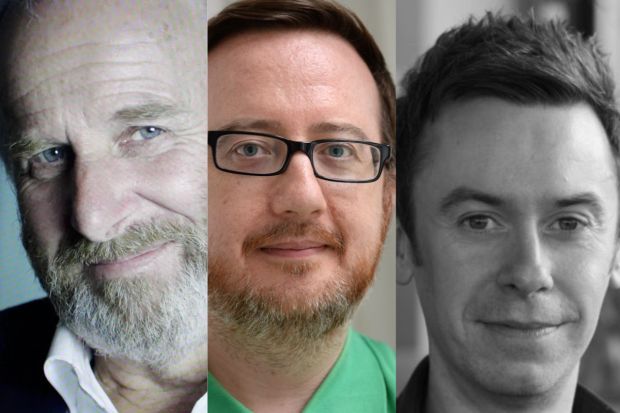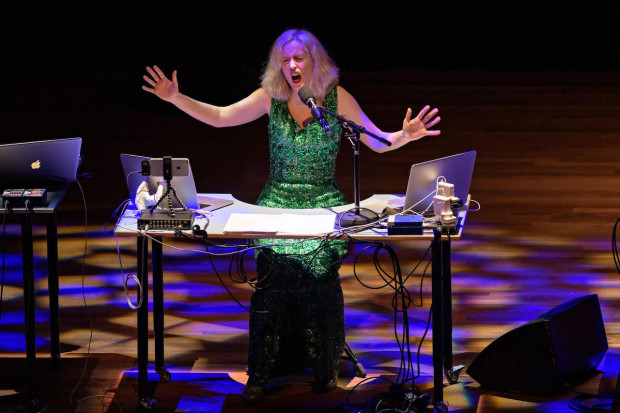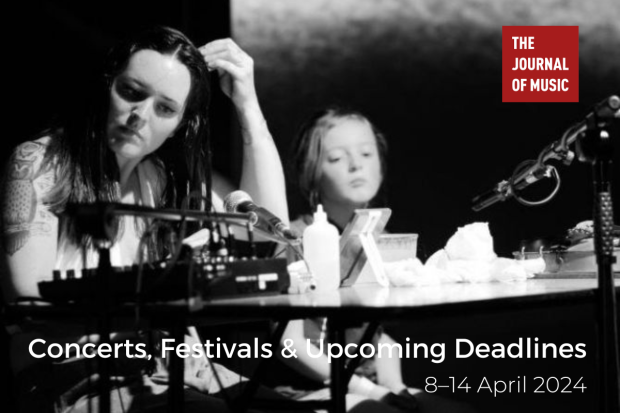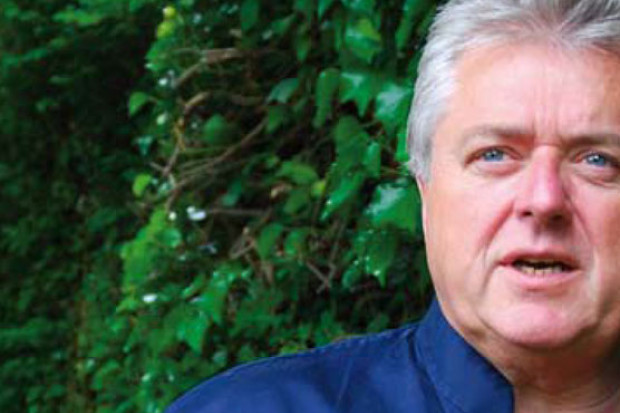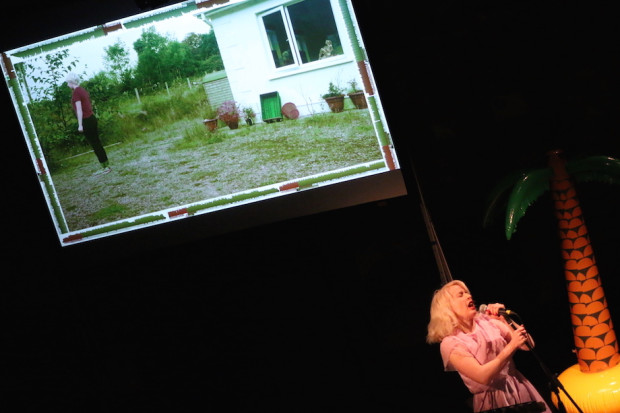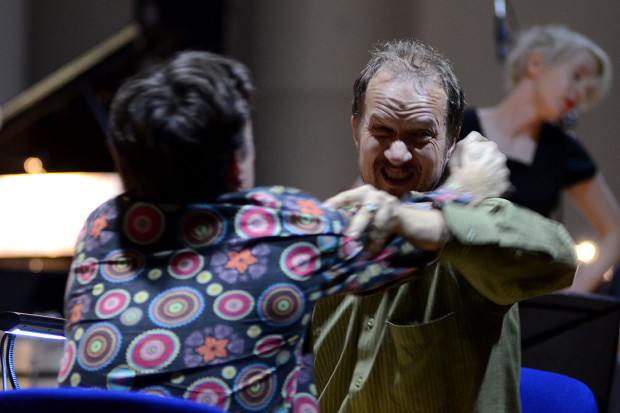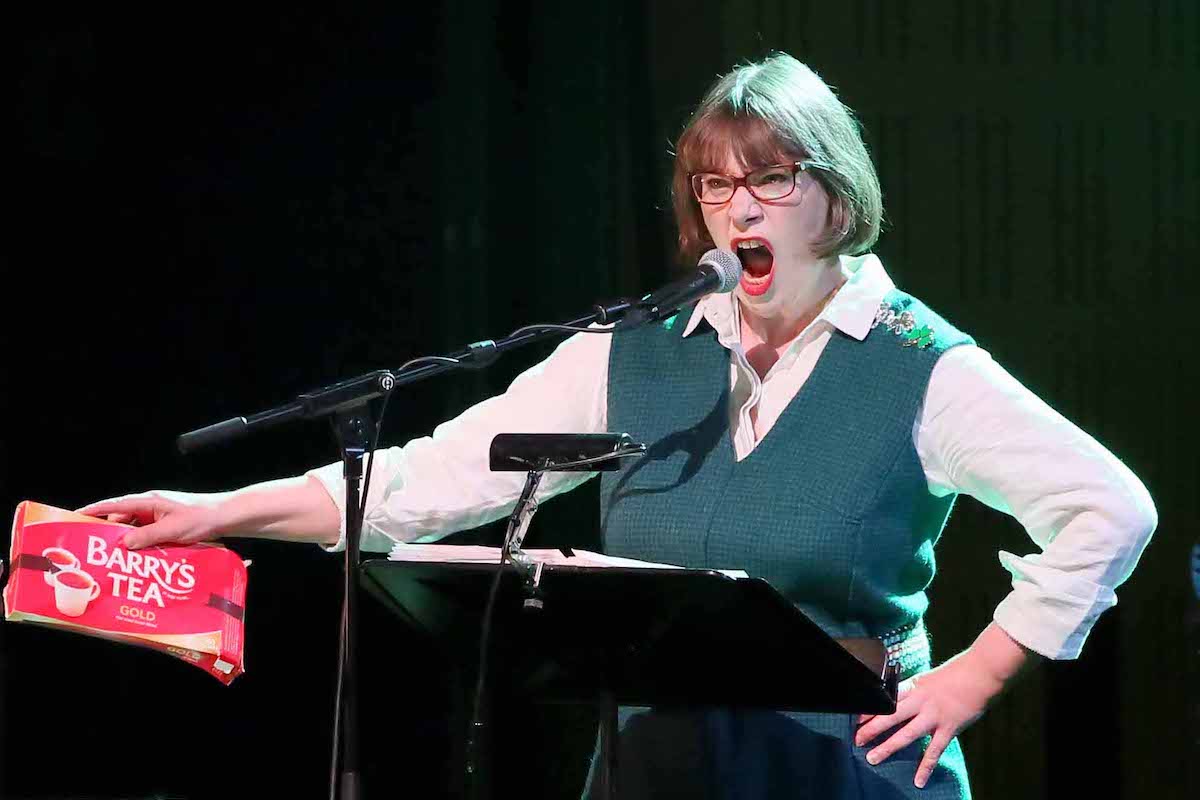
Elizabeth Hilliard in Jennifer Walshe's 'Ireland: A Dataset' (Photo: Mark Stedman)
The Futures We are Imagining are Too Narrow
There is a sense at the moment that a new conversation around the Gaeltacht is happening, not politically or in the media, but in music, theatre and art. It could be seen in the multi-disciplinary work Aisling? two years ago, in the creative ambition of Fíbín’s drive-in-drama Fiach during the lockdown, and now in Óró, directed by Darach Mac Con Iomaire.
The Gaeltacht needs new perspectives. A report in 2007 said there was 20 years left. A follow-up report in 2015 said the Gaeltacht would be gone in a decade. We are in unknown territory. Is the Gaeltacht dead, dying, or being reborn?
Óró took place last week (21–26 September) in a large, empty factory in Tismeáin, a road off the village of An Cheathrú Rua in Conamara. Ten performers from Ireland, Scotland, Fryslân (a province in the north of the Netherlands), Euskal Herria (the Basque country) and Kernow (Cornwall) were brought together to explore what they might have in common, and what they could create together. The two-hour show, a partnership between Ealaín na Gaeltachta and Galway 2020, develops as a series of scenes involving music, dance, movement and narrative. In the programme note, Mac Con Iomaire says it tells the story of a person coming to a new home that isn’t their native place. Óró is about personal expression, questioning, journeying, finding home. Are we imagining communities of the future? It felt like that.
Between them, the ten performers spoke five languages, and, in the course of the show, often they spoke different languages to each other, understanding each other through gesture: in one scene, actor Síle Nic Chonaonaigh sits embroidering while talking to Anne Feddema from Fryslân who is painting. She is talking in Irish about writing. Feddema responds intuitively and paints, speaking the minority language Frisian. We think we can understand him, because she seems to.
Óró begins with Diarmuid de Faoite speaking to Taran Spalding-Jenkin who responds in Cornish. Spalding-Jenkin is climbing a ladder trying to repair blinking lights by pointing his finger. De Faoite is impatient with him, talking to him condescendingly, like an old hand in a factory would to a new employee. De Faoite urges him to tell a story, properly, with gusto. Spalding-Jenkin eventually musters his narrative strength. The lights go out and characters begin spilling in from the surrounding areas.
We are not seated in one location for Óró. Every now and then, the stage managers approach a section of the audience and bring us to another space. In one room, the wall is lined with tiny paintings and Maitiú Ó Casaide sits in the corner playing a droning tune on fiddle. Contemporary dancer Amaia Elizaran from the Basque country writhes in the other corner. All of the paintings seem to portray people arriving at a destination, through darkness and woods.
Liam Ó Maonlaí’s upright piano sits at the centre of the factory floor. At times he sings solo, or accompanies Ó Casaide on pipes, or Scottish singer Josie Duncan, or Scottish small-piper Alana NicAonghais. Sometimes he wails above them all, to intense effect.
Óró is at its most exciting, however, when the two dancers, Elizaran and Sibéal Davitt (from Ireland), are at the centre. The opening scene sees them lock into a punching and shouting motion, and all the other performers align themselves with them and do the same. What are they fighting against? The future, the past, or the present? It’s a powerful beginning, and the size of the factory space means that every sound echoes around us.
Another memorable scene comes when we are brought to the opposite side of the factory. We hear a burst of laughter and move across the room to find it. Over a barrier, there is a long table covered with roses. De Faoite is clinging to a wooden pallet-base like it is a raft. Ó Casaide plays a slow air. Feddema stands at the other end of the table like an emperor. In the middle, Nic Chonaonaigh and the others howl with laughter. Eventually, de Faoite tries to make his way up the table, supplicating himself before Feddema. He arrives at the other side, but who is he now? What has he won and what has he relinquished to survive? He is transformed, less intimidated, more fluent in speech.
For the first seventy minutes I found Óró compelling; this was a dramatic reimagining that our pandemic-laboured world needs, and a passage of rapid-fire, playful prose by de Faoite after the rose-and-table scene would have been a worthy climax to the entire show. Óró continued, however, perhaps for more than it needed to. An exception was a solo water dance by Elizaran. There were four taps around the factory, most likely there from its original purpose. At times, the performers would turn them on, and soon large pools formed, eventually reaching Ó Maonlaí’s piano. An intense dance saw Elizaran use the water as a partner, pushing and pulling towards it, eventually relenting, and lying down in it. It was a reminder of the ecological crisis that is the backdrop to all other contemporary challenges.
The factory in An Cheathrú Rua was the fruit of the original Gaeltacht industrial vision: attract employers, hire locals, keep Irish alive. Now the factory lies empty, but it was filled with imagination. In one sense, Óró felt like a cry of pain as the Gaeltacht looks to its future. But it was also a free, fresh space that transcended language and where new ideas and old art forms combined easily. It challenges us to rethink our vision of the Gaeltacht, away from fixed, inherited ideas and imagine what else it could be. Whatever the future is, this is how it begins.
***
At the same time as Óró was taking place in Galway, the National Concert Hall in Dublin was streaming the world premiere of Jennifer Walshe’s new work (26 September), a piece featuring the vocal quartet Tonnta, saxophonist Nick Roth, and video segments.
As with Óró, Walshe’s Ireland: A Dataset is set on questioning who we think we are. It begins with a delicate disassembling of a shibboleth of Irish identity. The four members of the vocal group Tonnta take turns to explain why the film Man of Aran was a fabrication, both in the way the cast was chosen and the English that was overdubbed. While one Tonnta member speaks, others whisper dialogue from the film and, with Roth, create sounds of distant oceans with stones on drums or hair rubbed on microphones. Through the words of singer Simon MacHale, Walshe starts to present her thesis: ‘We build our worlds, we build our sense of reality, from the images of it presented to us, whether in film, literature, art or music.’
As MacHale’s words trail off, Roth’s saxophone and Tonnta begin to sing an AI-generated version of Enya’s ‘Orinoco Flow’, complete with comic 1990s Celtic hand-waving from Bláthnaid Conroy Murphy. Then Robbie Blake and Conroy Murphy transform into saccharine day-time TV hosts and present a make-up guide to being an Irishman – ‘Just lash it on, like you’re an animal or criminal or something … instead of toning down redness we want to increase it… shine… shine! … Now mess up those brows!’ This is Walshe at her funniest and in perhaps her most accessible work. Conroy Murphy and Elizabeth Hilliard switch to performing what sounds like a travel blog by two American tourists who visit the Hill of Tara (‘hashtag power spot!’).
But behind these funny episodes is always a unique mix of sounds, from whispered words to humming, like subliminal messages. There is mournfulness amongst the hilarity. Walshe continues to present her convictions about Irish identity on screen: ‘Datasets, culture, identity… these things are never neutral… they function as platforms for ideologies to run on … And as such, they cry out to be hacked.’
And subtle cultural hacking was evident throughout. In a cha cha-rhythmed song titled ‘Baile Ciúin’, Hilliard shakes a box of Barry’s Tea like a percussive shaker, followed by ‘A Short Lecture on the Picturesque’, nutty dancing to an AI-generated version The Dubliners, and an imagined scene at the 1893 Chicago Fair where different versions of Irish culture are presented in a dialogue between the singers. ‘We need to look like Irish people.’ ‘But we are Irish?’ ‘We need to look more like … how people who aren’t Irish think that the Irish people look like!’
This scene tended to lag slightly, but when the group followed it by singing an AI-generated version of the opening to Riverdance, it was hard not to burst out laughing, such was the brilliant sincerity with which Tonnta delivered it. A distorted version of the Late Late Show drum roll then led into renditions of AI-generated sean-nós that the quartet too had learnt by ear.
After forty minutes of the mesmerisingly absurd, Ireland: A Dataset ends with spoken reflections, on how a spec on a digital screen looked like a man climbing down to die, but who then decides not to. Images of Irish roads appear. After all the fun, Tonnta and Roth are able to bring the entire performance down to a subtle harmonising that gives the audience a moving space on which to reflect on everything we have seen.
What does it all point to? Walshe’s work is a clatter across the head for modern Irish identity. While Óró subtly slips in new ideas into the river of Irishness, Walshe gets down on the bank, moves large rocks around, and builds a dam to change its flow.
Performances like Ireland: A Dataset and Óró show us just how narrow we have allowed our society’s horizons and our public questioning to become. What is Ireland? What is the Gaeltacht? The more pertinent question is: what do we want them to be?
Published on 1 October 2020
Toner Quinn is Editor of the Journal of Music. His new book, What Ireland Can Teach the World About Music, is available here. Toner will be giving a lecture exploring some of the ideas in the book on Saturday 11 May 2024 at 3pm at Farmleigh House in Dublin. For booking, visit https://bit.ly/3x2yCL8.










